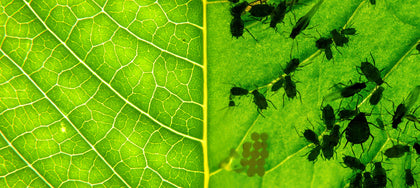So, you’re here to learn about pesticide safety, huh? You’ve got plants to protect, pests to vanquish, and you’d rather not get yourself or your leafy friends into a toxic pickle along the way. Some of the products sold here at AgChemUSA.com are hazardous to your health, and we want you to be safe. So, welcome to Pesticide Safety 101, where we’ll explore why those big, scary words on the labels actually matter, how to store pesticides like a pro, and some killer (but not literally) products that could make your pest woes disappear.
Let’s break down the basics in the most non-soul-crushing way possible.
Pesticide Signal Words: The Shortest Horror Story Ever
When you pick up a bottle of pesticide, there’s usually a word screaming at you from the front. "CAUTION," "WARNING," or "DANGER." Sound familiar? These aren't just there to spice up the packaging—they actually mean something. State and Federal regulations require manufacturers to place specific wording to help keep you, and anyone who comes in contact with these products safe.
CAUTION

A great example of this is, Tri-Tek, the Organic All-Rounder for Pest Control. Think of it as the sensitive friend of pest control products—gets the job done but won’t yell at you if you make accidental eye contact. This unique OMRI-listed concentrate is crafted with high-quality, highly refined, paraffinic oil, making it one of the safest and most effective options out there.
Unlike other heavy-duty pesticides that can cause burn or stress to plants, TriTek provides reliable protection across a broad spectrum of crops and ornamentals without compromising plant health. It’s an all-in-one fungicide, miticide, and insecticide that controls pests at multiple life stages—including those tricky eggs of spider mites, scales, aphids, and whiteflies.
WARNING

A great example of this, and favorite of ours is Piston TR, great for Greenhouse Pest Control in One Spray, is an insecticide. Ideal for when you need pests gone, but you’re willing to suit up for the task. When greenhouse pests have overstayed their welcome, Piston TR’s total release formula handles it all. With Chlorfenapyr as its active ingredient, this aerosol spray targets mites, thrips, and fungus gnats, delivering a one-two punch that works on contact and through ingestion. It disrupts pests' energy at the cellular level, stopping them fast and leaving plants unharmed.
DANGER
And here we are—the big leagues. If you see “DANGER” on a label, it’s the kind of product you don’t want to mess around with. This stuff can cause real harm, whether you breathe it in, get it on your skin, or (accidentally) sample it. Save the “DANGER” products for the toughest situations, and bring your A-game protection.
 An example of this would be Pylon, a miticide. It’s fierce, it’s effective, and it’s definitely not for the faint-hearted (or ungloved).
An example of this would be Pylon, a miticide. It’s fierce, it’s effective, and it’s definitely not for the faint-hearted (or ungloved).
Pylon is great for when your greenhouse needs a bouncer and it certainly isn't your average pest control—it’s the powerhouse you call in when other options just don’t cut it. Designed for serious greenhouse pest control, Pylon tackles caterpillars, western flower thrips, fungus gnats, and a whole host of mites. Its secret weapon? Messing with pests at the cellular level by disrupting energy production. Without their precious ATP, these unwelcome guests are left energy-starved and out for good. Just remember, Pylon's not for plants in bloom, and it provides up to 21 days of protection per application—gloves required!
Oh, and there’s the “POISON” label too. Basically, that’s “DANGER” but extra. Think of it as the label’s way of saying, “Please do not make me your perfume.” If it’s labeled “POISON,” follow the directions to the letter.
Pesticide Storage: Avoid the Chemical Jenga in Your Garage
Alright, so you’ve got your pesticides, insecticides, herbicides, fertilizers, and who knows what else. But now what? Please don’t just stash them in the garage between the soccer balls and spare paint cans, or sit out back behind the barn, exposed to every element under the sun. Pesticides need special care—kind of like plants, but more deadly. 
1. Find a Safe Spot
Think secure, think high, think away from kids and pets. You don’t want Fido or Little Timmy knocking over a bottle of Pyrethrum TR because someone wanted to play garage hide-and-seek.
2. Avoid Extreme Temperatures
Store them somewhere with steady temps. Extremes can mess with their effectiveness or even make them leak. And nobody wants to explain to their neighbors why their garage smells like bug spray.

3. Original Containers Only
Look, I get it, the temptation to put things in prettier bottles is real. But in this case? Resist. Always keep pesticides in their original containers with the labels intact. That way, you know exactly what’s what and what precautions to take.
Pesticide Application: Because There Is a Right Way to Spray
Now that your pesticides are safe and sound, it’s time to use them. Here’s the thing: proper application isn’t just about aiming at pests and hoping for the best. There’s a bit of finesse involved.
1. Suit Up
Depending on the product, you might need gloves, goggles, or even a mask. Yes, it may look a little “Ghostbusters” (or maybe that’s a plus?), but trust me, better safe than regretting you didn’t wear the gloves.
2. Watch the Wind
No one wants a face full of pesticide mist because they didn’t check the breeze. Choose a calm day or spray close to your target to keep things under control.
3. Respect the Instructions
Each product has its own magic formula for best results. Don’t go rogue here—follow the label instructions on dilution, application frequency, and target pests. The directions aren’t just for show; they’re there to make sure you’re safe and effective.
Why Does Pesticide Safety Matter?
Apart from the obvious—staying out of the ER—using pesticides safely means you’ll get the results you’re after without unintended harm. The signal words, application instructions, and storage guidelines all work together to keep you and your plants in good shape. Plus, safe use ensures that pests get the boot without creating new problems for you, your crops, or the environment.
And speaking of being thorough, AgChemUSA.com is packed with products to suit every pest-control scenario—from the friendly “CAUTION” level options for everyday gardeners to the heavy-duty “DANGER” level solutions for big-time growers.
Takeaway: Pesticide safety isn’t rocket science, but it’s also not something you can skip. Remember, every word on that label exists to make your life easier—and your pest control way safer.





